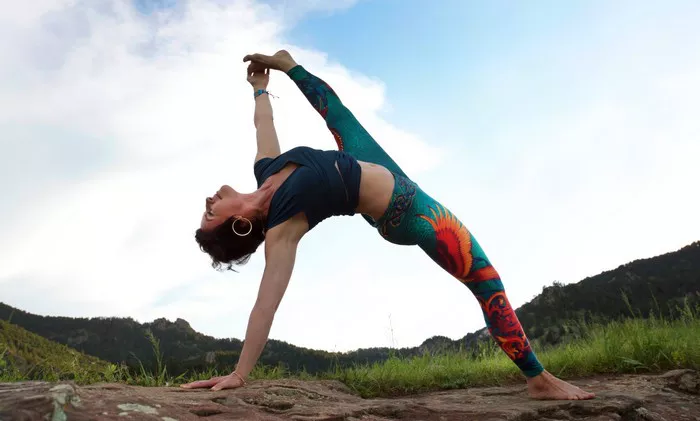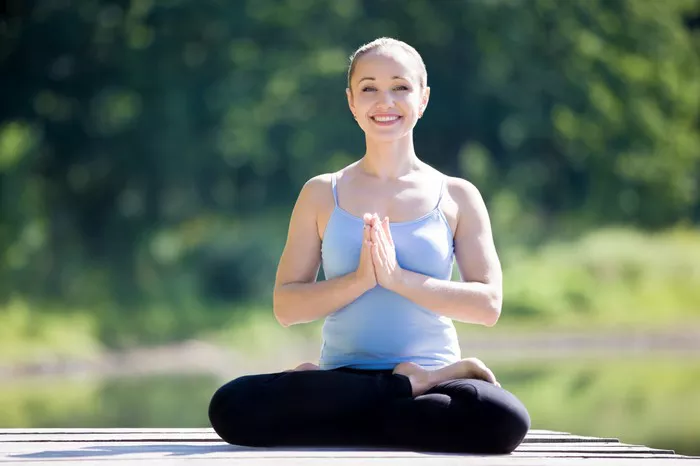Restorative yoga is a style of yoga focused on relaxation and recovery, using props like blankets, bolsters, and blocks to support the body in restful poses. One of the most accessible and versatile props for restorative yoga is the chair. Chair yoga offers an effective and comfortable way to practice restorative poses for people of all ages and abilities, particularly for those who have difficulty getting on the floor or have limited mobility.
In this article, we will explore how restorative yoga with a chair can enhance your well-being, provide relaxation, and help you release stress. We will discuss the benefits of this practice, key restorative chair yoga poses, and how to get started with a simple chair yoga routine that you can do at home or in a class setting.
What Is Restorative Yoga?
Restorative yoga is a gentle style of yoga designed to help the body and mind relax deeply. The focus is on holding poses for an extended period of time (usually between 5-20 minutes) with the support of props, to allow the muscles to release tension and the nervous system to calm down.
The key features of restorative yoga include:
Slow-paced movements: Poses are typically held for longer periods to encourage deep relaxation.
Use of props: Blankets, bolsters, straps, and chairs are commonly used to support the body.
Focus on breath: Deep breathing is a central component of restorative yoga, helping to activate the parasympathetic nervous system (the “rest and digest” system).
Relaxation: The practice encourages letting go of stress and promoting physical and mental recovery.
This style of yoga is accessible to everyone, regardless of experience level or flexibility, making it ideal for beginners, seniors, and those recovering from injury or illness.
How Does a Chair Enhance Restorative Yoga?
In restorative yoga, props help you find stability and comfort in the poses, and the chair serves as a versatile prop that brings many benefits to the practice. Using a chair provides additional support, making restorative yoga accessible to those with limited mobility or who have difficulty getting up and down from the floor.
Here are some key reasons why a chair is helpful in restorative yoga:
Increased accessibility: A chair allows individuals who have trouble sitting on the floor or who experience joint pain to still participate in restorative yoga.
Support and stability: The chair offers a stable foundation to perform poses safely and comfortably, even for extended periods.
Improved alignment: A chair can help maintain proper posture and alignment in poses, especially for people who may find it difficult to sit or lie on the floor.
Ease of transition: The chair helps with transitions between poses, making the practice more accessible to those with limited range of motion.
Whether you’re working with chronic pain, recovering from surgery, or simply seeking a more comfortable way to relax, a chair provides a practical tool for deep restorative practices.
Benefits of Restorative Yoga with a Chair
Practicing restorative yoga with a chair offers several important physical, emotional, and mental benefits. Let’s explore the key advantages of this practice:
Physical Benefits
Pain Relief and Tension Reduction: Restorative yoga helps release muscle tension and can alleviate chronic pain, especially in the back, neck, and shoulders. The support of the chair allows you to relax deeply without overexerting your body.
Improved Flexibility: Chair yoga poses can improve flexibility, especially in the hips, hamstrings, and spine. The use of the chair encourages proper alignment and allows you to hold stretches for a longer time, gradually increasing your flexibility.
Enhanced Circulation: The slow and mindful movements involved in restorative yoga promote blood circulation throughout the body. This can be particularly beneficial for individuals who sit for long periods during the day or have circulation issues.
Better Posture: Sitting in a chair can help you focus on your posture and body alignment, encouraging better spinal health and reducing the risk of musculoskeletal problems.
Mental Benefits
Stress Relief: Restorative yoga promotes relaxation by activating the parasympathetic nervous system, which helps to reduce stress and anxiety. The practice encourages mindful breathing, which calms the mind and body.
Improved Sleep: Regular restorative yoga practice can improve the quality of sleep by calming the nervous system and promoting a deeper sense of relaxation before bedtime.
Mental Clarity: Restorative yoga encourages a focused, meditative state of mind. By taking time to slow down and focus on your breath, you can reduce mental clutter and gain clarity.
Emotional Benefits
Emotional Healing: As restorative yoga helps release physical tension, it can also help to release emotional blockages and stored stress. The practice encourages deep introspection and provides space for emotional healing.
Increased Calmness: Regular practice of restorative yoga can help you develop a sense of inner peace and calm. It offers a way to connect to your body and mind, reducing feelings of overwhelm or anxiety.
A Sense of Nurturing: Restorative yoga with a chair allows you to feel supported and cared for. This gentle practice offers a nurturing environment that promotes self-compassion and emotional well-being.
Key Chair Yoga Poses for Restorative Practice
While restorative yoga involves holding poses for long periods, the use of a chair allows you to access these benefits in a safe and comfortable way. Below are some simple yet effective chair yoga poses that can be used in your restorative yoga routine:
1. Seated Forward Fold (Paschimottanasana)
This gentle stretch targets the hamstrings and lower back, helping to release tension.
How to do it:
Sit on the edge of the chair with your feet hip-width apart.
Inhale and lengthen your spine, reaching up through the crown of your head.
Exhale as you fold forward from your hips, reaching for your feet, shins, or the floor.
Allow your head and neck to relax as you hold the pose for 5-10 minutes, focusing on deep breathing.
Benefits: Relieves tension in the back and hamstrings, improves flexibility in the spine.
2. Seated Cat-Cow Stretch
This simple movement helps improve spinal flexibility and releases tension in the back.
How to do it:
Sit with your feet flat on the floor and your hands resting on your thighs.
Inhale as you arch your back and open your chest (Cow Pose).
Exhale as you round your spine, tucking your chin toward your chest (Cat Pose).
Repeat for 5-10 rounds, moving slowly and mindfully with your breath.
Benefits: Increases mobility in the spine, improves posture, and releases tension in the back.
3. Supported Chest Opener
This pose helps to release tightness in the chest and shoulders, promoting relaxation and better posture.
How to do it:
Sit tall with your feet flat on the floor and your hands resting on your thighs.
Inhale as you gently press your palms forward on the armrests of the chair, opening your chest.
Hold the position for 3-5 minutes, breathing deeply and allowing your chest to expand with each inhale.
Benefits: Opens the chest, improves posture, and reduces shoulder tension.
4. Seated Twist (Ardha Matsyendrasana)
This restorative twist helps to release tension in the spine, improve flexibility, and calm the nervous system.
How to do it:
Sit tall with your feet flat on the floor and your spine long.
Place your right hand on the back of the chair and your left hand on your right thigh.
Gently twist your torso to the right, looking over your right shoulder. Keep your hips facing forward.
Hold for 3-5 minutes, breathing deeply, and then switch sides.
Benefits: Improves spinal flexibility, massages internal organs, and promotes digestion.
5. Seated Savasana
A deep relaxation pose, Savasana is the cornerstone of restorative yoga.
How to do it:
Sit in a chair with your feet flat on the floor, spine tall, and hands resting on your thighs or in your lap.
Close your eyes and focus on your breath. Allow your body to relax deeply into the chair.
Stay in this pose for 5-20 minutes, allowing your body to rest and your mind to quiet.
Benefits: Deep relaxation, stress relief, and mental clarity.
See Also: Self-Restorative Yoga: A Path to Healing and Rejuvenation
How to Get Started with Chair Yoga
To get started with restorative yoga using a chair, it’s important to focus on finding a comfortable, stable chair with a firm seat. Look for a chair with a straight back to support proper posture, and make sure your feet are flat on the floor when you sit. Here’s a simple routine to try at home:
Beginner Chair Yoga Routine:
- Seated Forward Fold – 3-5 minutes
- Seated Cat-Cow Stretch – 5 rounds
- Supported Chest Opener – 3-5 minutes
- Seated Twist – 3-5 minutes on each side
- Seated Savasana – 5-10 minutes
Start by practicing for just 15-20 minutes a day, gradually increasing the time as you become more comfortable. Focus on breathing deeply and allowing yourself to fully relax into each pose.
Conclusion
Restorative yoga with a chair offers a powerful way to promote relaxation, reduce stress, and improve physical and emotional well-being. Whether you’re looking for relief from chronic pain, better posture, or simply a way to unwind after a long day, chair yoga can be a valuable practice. By integrating simple chair yoga poses into your daily routine, you can enhance flexibility, build strength, and experience deep relaxation—all while remaining supported and comfortable.
With its accessibility and focus on relaxation, restorative yoga with a chair is a wonderful option for anyone seeking to nurture their body and mind in a gentle, restorative way. Start your journey today, and enjoy the many benefits that this mindful practice has to offer.
You Might Be Interested In























